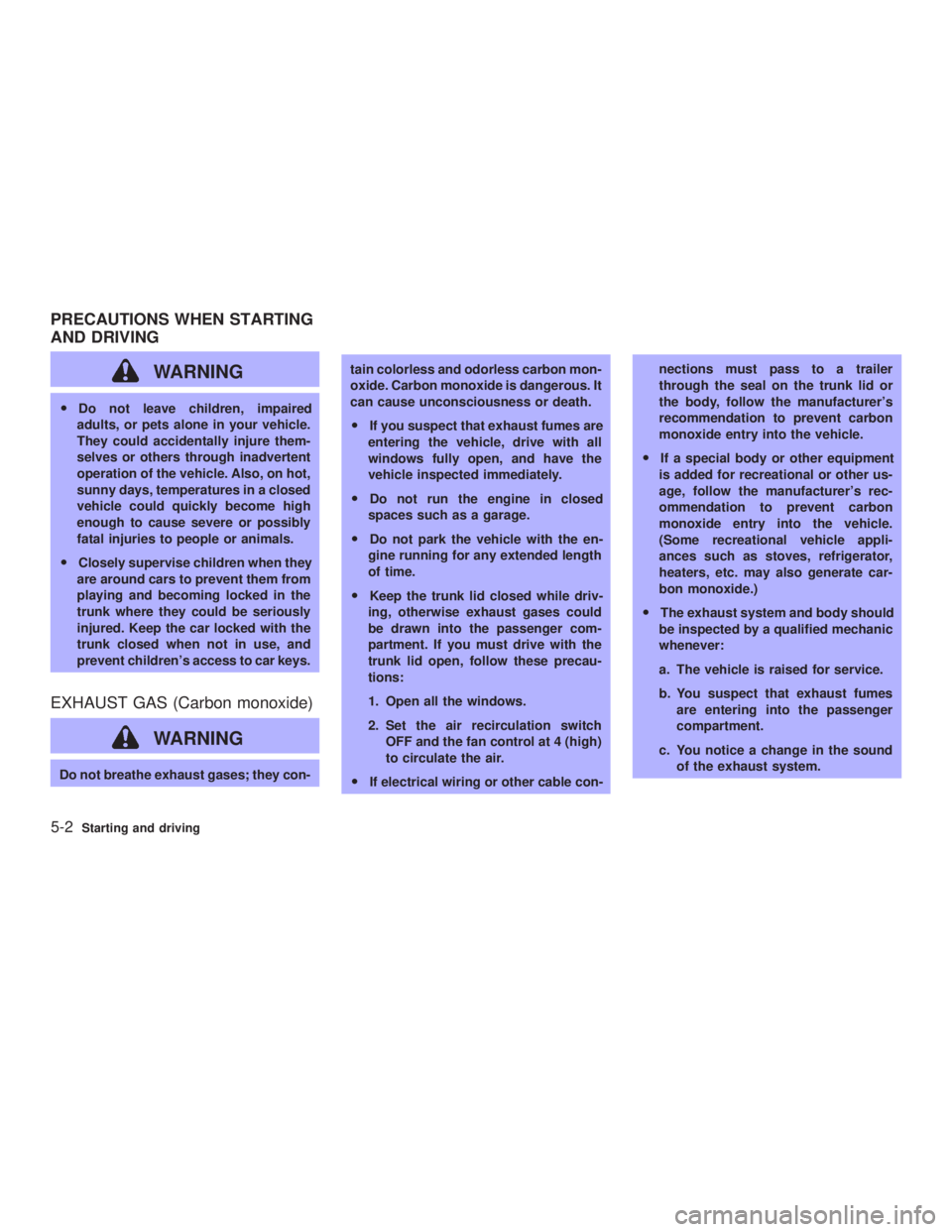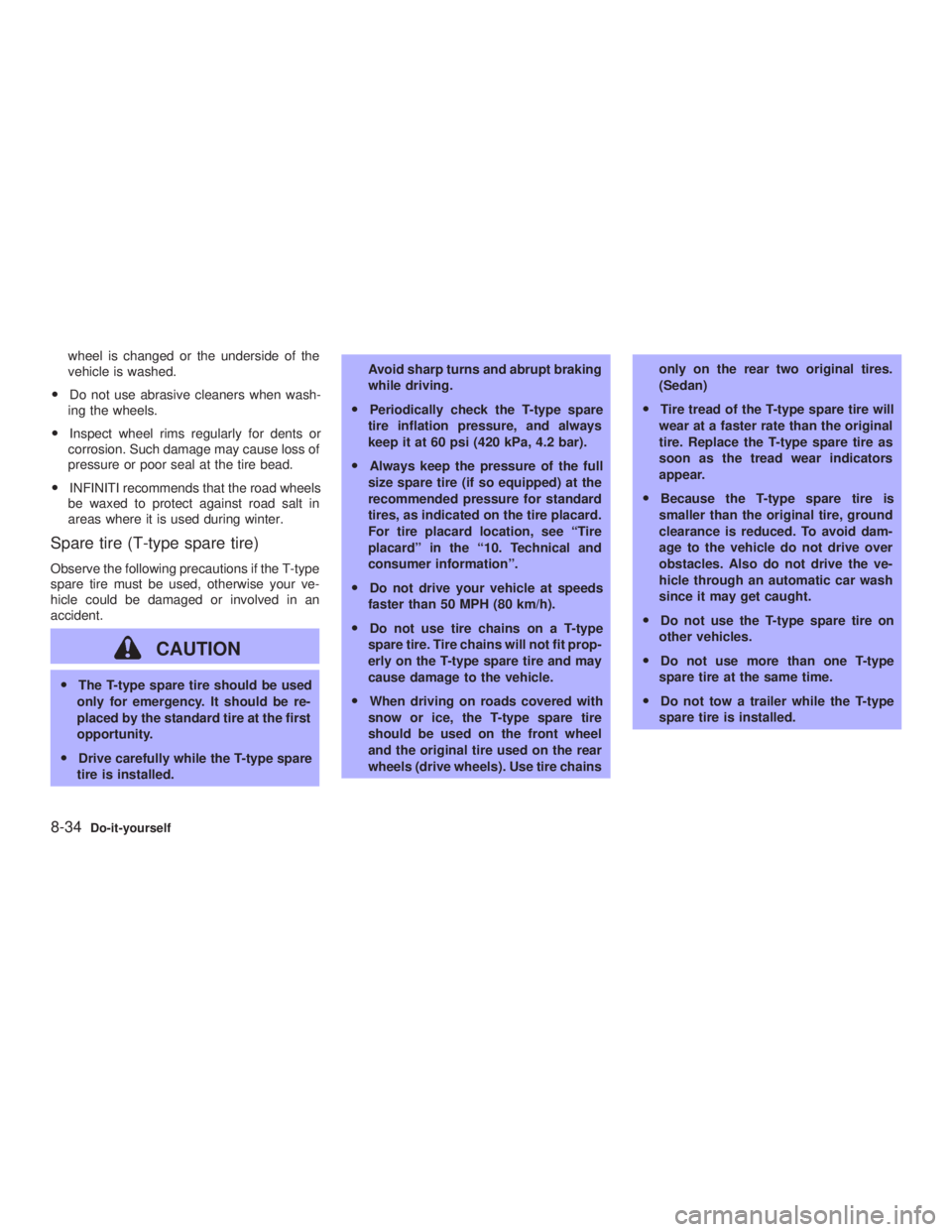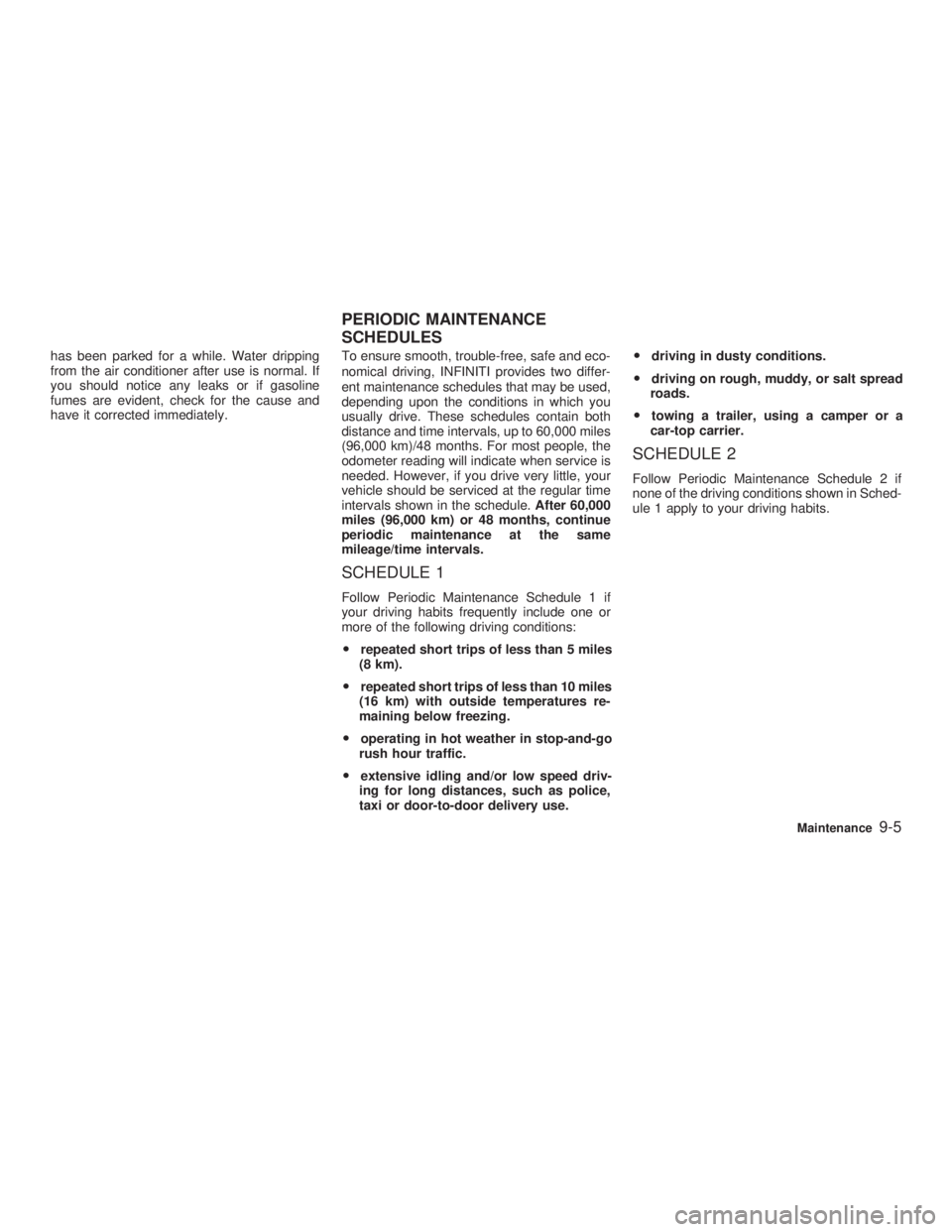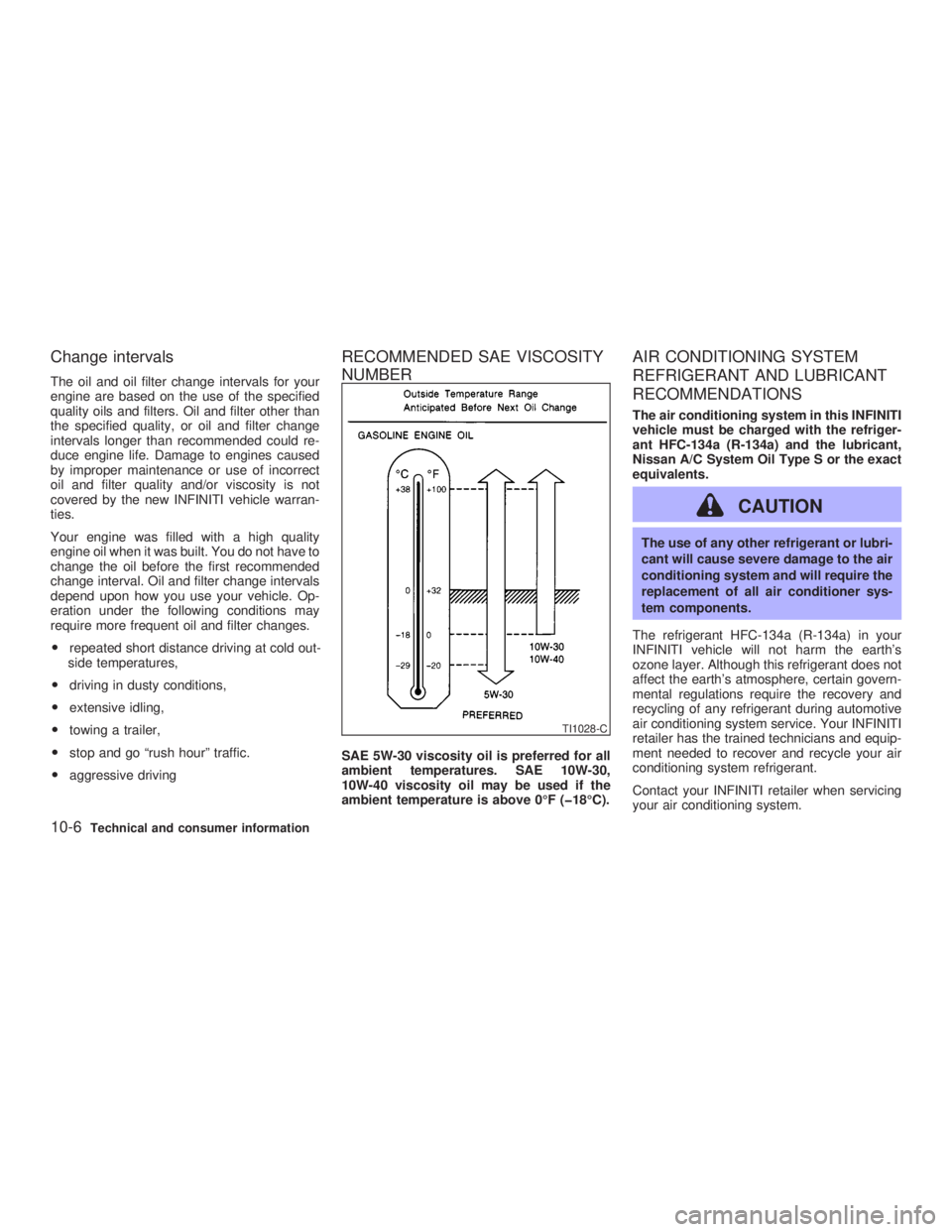2003 INFINITI G35 trailer
[x] Cancel search: trailerPage 109 of 256

ously injured if it is misused or mis-
handled. Always stop the engine and
do not smoke or allow open flames or
sparks near the vehicle when refuel-
ing.
O Fuel may be under pressure. Turn the
cap a quarter turn, and wait for any
hissing sound to stop to prevent fuel
from spraying out and possible per-
sonal injury. Then remove the cap.
O Do not attempt to top off the fuel tank after the fuel pump nozzle shuts off
automatically.
Continued refueling may cause fuel
overflow, resulting in fuel spray and
possibly a fire.
O Use only an original equipment type
fuel filler cap as a replacement. It has
a built-in safety valve needed for
proper operation of the fuel system
and emission control system. An in-
correct cap can result in a serious
malfunction and possible injury. It
could also cause the malfunc-
tion indicator lamp to come on.
O Do not fill a portable fuel container in
the vehicle or trailer. Static electricity
can cause an explosion of flammable
liquid, vapor or gas in any vehicle or
trailer. To reduce the risk of serious
injury or death when filling portable
fuel containers:
Ð Always place the container on the
ground when filling.
Ð Do not use electronic devices
while filling.
Ð Keep the pump nozzle in contact
with the container while you are
filling it. Ð Use only approved portable fuel
containers for flammable liquid.
O Never pour fuel into the throttle body
to attempt to start your vehicle.
CAUTION O If fuel is spilled on the car body, flush
it away with water to avoid paint dam-
age.
O Tighten until the fuel filler cap clicks.
Failure to tighten the fuel filler cap
properly may cause the
mal-
function indicator lamp (MIL) to illu-
minate. If the
lamp illuminates
because the fuel filler cap is loose or
missing, tighten or install the cap and
continue to drive the vehicle. The
lamp should turn off after a few
driving trips. If the
lamp does
not turn off after a few driving trips,
have the vehicle inspected by an au-
thorized INFINITI retailer.SPA1563
Pre-driving checks and adjustments
3-15
Z 02.7.29/V35-D/V5.0
X
Page 136 of 256

WARNINGO Do not leave children, impaired
adults, or pets alone in your vehicle.
They could accidentally injure them-
selves or others through inadvertent
operation of the vehicle. Also, on hot,
sunny days, temperatures in a closed
vehicle could quickly become high
enough to cause severe or possibly
fatal injuries to people or animals.
O Closely supervise children when they
are around cars to prevent them from
playing and becoming locked in the
trunk where they could be seriously
injured. Keep the car locked with the
trunk closed when not in use, and
prevent children's access to car keys.
EXHAUST GAS (Carbon monoxide)
WARNINGDo not breathe exhaust gases; they con- tain colorless and odorless carbon mon-
oxide. Carbon monoxide is dangerous. It
can cause unconsciousness or death.
O If you suspect that exhaust fumes are
entering the vehicle, drive with all
windows fully open, and have the
vehicle inspected immediately.
O Do not run the engine in closed
spaces such as a garage.
O Do not park the vehicle with the en-
gine running for any extended length
of time.
O Keep the trunk lid closed while driv-
ing, otherwise exhaust gases could
be drawn into the passenger com-
partment. If you must drive with the
trunk lid open, follow these precau-
tions:
1. Open all the windows.
2. Set the air recirculation switch
OFF and the fan control at 4 (high)
to circulate the air.
O If electrical wiring or other cable con- nections must pass to a trailer
through the seal on the trunk lid or
the body, follow the manufacturer's
recommendation to prevent carbon
monoxide entry into the vehicle.
O If a special body or other equipment
is added for recreational or other us-
age, follow the manufacturer's rec-
ommendation to prevent carbon
monoxide entry into the vehicle.
(Some recreational vehicle appli-
ances such as stoves, refrigerator,
heaters, etc. may also generate car-
bon monoxide.)
O The exhaust system and body should
be inspected by a qualified mechanic
whenever:
a. The vehicle is raised for service.
b. You suspect that exhaust fumes
are entering into the passenger
compartment.
c. You notice a change in the sound
of the exhaust system.PRECAUTIONS WHEN STARTING
AND DRIVING
5-2 Starting and driving
Z 02.7.29/V35-D/V5.0
X
Page 151 of 256

During the first 1,200 miles (2,000 km), follow
these recommendations to obtain maximum
engine performance and ensure the future
reliability and economy of your new vehicle.
Failure to follow these recommendations may
result in shortened engine life and reduced
engine performance.
O Avoid driving for long periods at constant
speed, either fast or slow. Do not run the
engine over 4,000 rpm.
O Do not accelerate at full throttle in any gear.
O Avoid quick starts.
O Avoid hard braking as much as possible.
O Do not tow a trailer for the first 500 miles
(800 km). O Accelerate slowly and smoothly. Maintain
cruising speeds with a constant accelerator
position.
O Drive at moderate speeds on the highway.
Driving at high speed will lower fuel
economy.
O Avoid unnecessary stopping and braking.
Maintain a safe distance behind other ve-
hicles.
O Use a proper gear range which suits road
conditions. On level roads, shift into high
gear as soon as possible.
O Avoid unnecessary engine idling. O Keep your engine tuned up.
O Follow the recommended periodic mainte-
nance schedule.
O Keep the tires inflated at the correct pres-
sure. Low pressure will increase tire wear
and waste fuel.
O Keep the front wheels in correct alignment.
Improper alignment will cause not only tire
wear but also lower fuel economy.
O Air conditioner operation lowers fuel
economy. Use the air conditioner only when
necessary.
O When cruising at highway speeds, it is
more economical to use the air conditioner
and leave the windows closed to reduce
drag. SD1001M
BREAK-IN SCHEDULE INCREASING FUEL ECONOMY
Starting and driving
5-17
Z 02.7.29/V35-D/V5.0
X
Page 212 of 256

wheel is changed or the underside of the
vehicle is washed.
O Do not use abrasive cleaners when wash-
ing the wheels.
O Inspect wheel rims regularly for dents or
corrosion. Such damage may cause loss of
pressure or poor seal at the tire bead.
O INFINITI recommends that the road wheels
be waxed to protect against road salt in
areas where it is used during winter.
Spare tire (T-type spare tire) Observe the following precautions if the T-type
spare tire must be used, otherwise your ve-
hicle could be damaged or involved in an
accident.
CAUTIONO The T-type spare tire should be used
only for emergency. It should be re-
placed by the standard tire at the first
opportunity.
O Drive carefully while the T-type spare
tire is installed. Avoid sharp turns and abrupt braking
while driving.
O Periodically check the T-type spare
tire inflation pressure, and always
keep it at 60 psi (420 kPa, 4.2 bar).
O Always keep the pressure of the full
size spare tire (if so equipped) at the
recommended pressure for standard
tires, as indicated on the tire placard.
For tire placard location, see ªTire
placardº in the ª10. Technical and
consumer informationº.
O Do not drive your vehicle at speeds
faster than 50 MPH (80 km/h).
O Do not use tire chains on a T-type
spare tire. Tire chains will not fit prop-
erly on the T-type spare tire and may
cause damage to the vehicle.
O When driving on roads covered with
snow or ice, the T-type spare tire
should be used on the front wheel
and the original tire used on the rear
wheels (drive wheels). Use tire chains only on the rear two original tires.
(Sedan)
O Tire tread of the T-type spare tire will
wear at a faster rate than the original
tire. Replace the T-type spare tire as
soon as the tread wear indicators
appear.
O Because the T-type spare tire is
smaller than the original tire, ground
clearance is reduced. To avoid dam-
age to the vehicle do not drive over
obstacles. Also do not drive the ve-
hicle through an automatic car wash
since it may get caught.
O Do not use the T-type spare tire on
other vehicles.
O Do not use more than one T-type
spare tire at the same time.
O Do not tow a trailer while the T-type
spare tire is installed.
8-34 Do-it-yourself
Z 02.7.29/V35-D/V5.0
X
Page 217 of 256

has been parked for a while. Water dripping
from the air conditioner after use is normal. If
you should notice any leaks or if gasoline
fumes are evident, check for the cause and
have it corrected immediately. To ensure smooth, trouble-free, safe and eco-
nomical driving, INFINITI provides two differ-
ent maintenance schedules that may be used,
depending upon the conditions in which you
usually drive. These schedules contain both
distance and time intervals, up to 60,000 miles
(96,000 km)/48 months. For most people, the
odometer reading will indicate when service is
needed. However, if you drive very little, your
vehicle should be serviced at the regular time
intervals shown in the schedule. After 60,000
miles (96,000 km) or 48 months, continue
periodic maintenance at the same
mileage/time intervals.
SCHEDULE 1 Follow Periodic Maintenance Schedule 1 if
your driving habits frequently include one or
more of the following driving conditions:
O repeated short trips of less than 5 miles
(8 km).
O repeated short trips of less than 10 miles
(16 km) with outside temperatures re-
maining below freezing.
O operating in hot weather in stop-and-go
rush hour traffic.
O extensive idling and/or low speed driv-
ing for long distances, such as police,
taxi or door-to-door delivery use. O driving in dusty conditions.
O driving on rough, muddy, or salt spread
roads.
O towing a trailer, using a camper or a
car-top carrier.
SCHEDULE 2 Follow Periodic Maintenance Schedule 2 if
none of the driving conditions shown in Sched-
ule 1 apply to your driving habits.PERIODIC MAINTENANCE
SCHEDULES
Maintenance
9-5
Z 02.7.29/V35-D/V5.0
X
Page 219 of 256

Schedule 1 Abbreviations: R = Replace, I = Inspect. Correct or replace if necessary. MAINTENANCE OPERATION MAINTENANCE INTERVAL
Perform at number of miles, kilometers or
months, whichever comes first. Miles x 1,000 3.75 7.5 11.25 15 18.75 22.5 26.25 30 33.75 37.5 41.25 45 48.75 52.5 56.25 60
(km x 1,000) (6) (12) (18) (24) (30) (36) (42) (48) (54) (60) (66) (72) (78) (84) (90) (96)
Months 3 6 9 12 15 18 21 24 27 30 33 36 39 42 45 48
CHASSIS AND BODY MAINTENANCE
Brake lines & cables IIII
Brake pads & rotors IIIIIIII
Manual transmission gear oil or automatic trans-
mission fluid & differential gear oil See NOTE (1) IIII
Steering gear & linkage, axle & suspension parts IIIIIIII
Tire rotation See NOTE (2)
Exhaust system IIIIIIII
In-cabin microfilter RRRR
NOTE: (1) If towing a trailer, using a camper or a car-top carrier, or driving on rough or muddy roads, change (not just inspect) oil at every 30,000 miles (48,000 km)
or 24 months. Using automatic transmission fluid other than Genuine Nissan ATF Matic Fluid J will cause deterioration in driveability and automatic
transmission durability, and may damage the automatic transmission, which is not covered by the INFINITI new vehicle limited warranty.
(2) Refer to ªTire rotationº under the ªGeneral maintenanceº heading earlier in this section.
Maintenance
9-7
Z 02.7.29/V35-D/V5.0
X
Page 223 of 256

10 Technical and consumer information Capacities and recommended fuel/lubricants/
fluids ........................................................................ 10-2
Fuel recommendation ......................................... 10-3
Engine oil and oil filter recommendation ............ 10-5
Recommended SAE viscosity number ............... 10-6
Air conditioning system refrigerant and lubricant
recommendations ............................................... 10-6
Specifications .......................................................... 10-7
Engine ................................................................ 10-7
Wheels and tires ................................................ 10-8
Dimensions and weights .................................... 10-8
When traveling or registering your vehicle in
another country ....................................................... 10-9
Vehicle identification ............................................... 10-9
Vehicle identification number (VIN) plate ........... 10-9
Vehicle identification number
(Chassis number) ............................................... 10-9
Engine serial number ....................................... 10-10
F.M.V.S.S. certification label ............................ 10-10
Emission control information label ................... 10-11
Tire placard ...................................................... 10-11
Air conditioner specification label ..................... 10-12
Installing front bumper cover................................. 10-12
Installing front license plate................................... 10-13 Vehicle loading information ................................... 10-14
Terms ............................................................... 10-14
Determining vehicle load capacity.................... 10-14
Loading tips ...................................................... 10-15
Towing a trailer ..................................................... 10-15
Maximum load limits ......................................... 10-16
Towing safety ................................................... 10-17
Uniform tire quality grading ................................... 10-19
Emission control system warranty ........................ 10-20
Reporting safety defects (US only) ....................... 10-21
Readiness for inspection/maintenance (I/M) test
(US only) ............................................................... 10-21
Owner's Manual/Service Manual order
information............................................................. 10-22
In the event of a collision ................................. 10-22
Z 02.7.29/V35-D/V5.0
X
Page 228 of 256

Change intervals The oil and oil filter change intervals for your
engine are based on the use of the specified
quality oils and filters. Oil and filter other than
the specified quality, or oil and filter change
intervals longer than recommended could re-
duce engine life. Damage to engines caused
by improper maintenance or use of incorrect
oil and filter quality and/or viscosity is not
covered by the new INFINITI vehicle warran-
ties.
Your engine was filled with a high quality
engine oil when it was built. You do not have to
change the oil before the first recommended
change interval. Oil and filter change intervals
depend upon how you use your vehicle. Op-
eration under the following conditions may
require more frequent oil and filter changes.
O repeated short distance driving at cold out-
side temperatures,
O driving in dusty conditions,
O extensive idling,
O towing a trailer,
O stop and go ªrush hourº traffic.
O aggressive driving RECOMMENDED SAE VISCOSITY
NUMBER
SAE 5W-30 viscosity oil is preferred for all
ambient temperatures. SAE 10W-30,
10W-40 viscosity oil may be used if the
ambient temperature is above 0ÉF (þ18ÉC). AIR CONDITIONING SYSTEM
REFRIGERANT AND LUBRICANT
RECOMMENDATIONS The air conditioning system in this INFINITI
vehicle must be charged with the refriger-
ant HFC-134a (R-134a) and the lubricant,
Nissan A/C System Oil Type S or the exact
equivalents.
CAUTION The use of any other refrigerant or lubri-
cant will cause severe damage to the air
conditioning system and will require the
replacement of all air conditioner sys-
tem components.
The refrigerant HFC-134a (R-134a) in your
INFINITI vehicle will not harm the earth's
ozone layer. Although this refrigerant does not
affect the earth's atmosphere, certain govern-
mental regulations require the recovery and
recycling of any refrigerant during automotive
air conditioning system service. Your INFINITI
retailer has the trained technicians and equip-
ment needed to recover and recycle your air
conditioning system refrigerant.
Contact your INFINITI retailer when servicing
your air conditioning system. TI1028-C
10-6 Technical and consumer information
Z 02.7.29/V35-D/V5.0
X